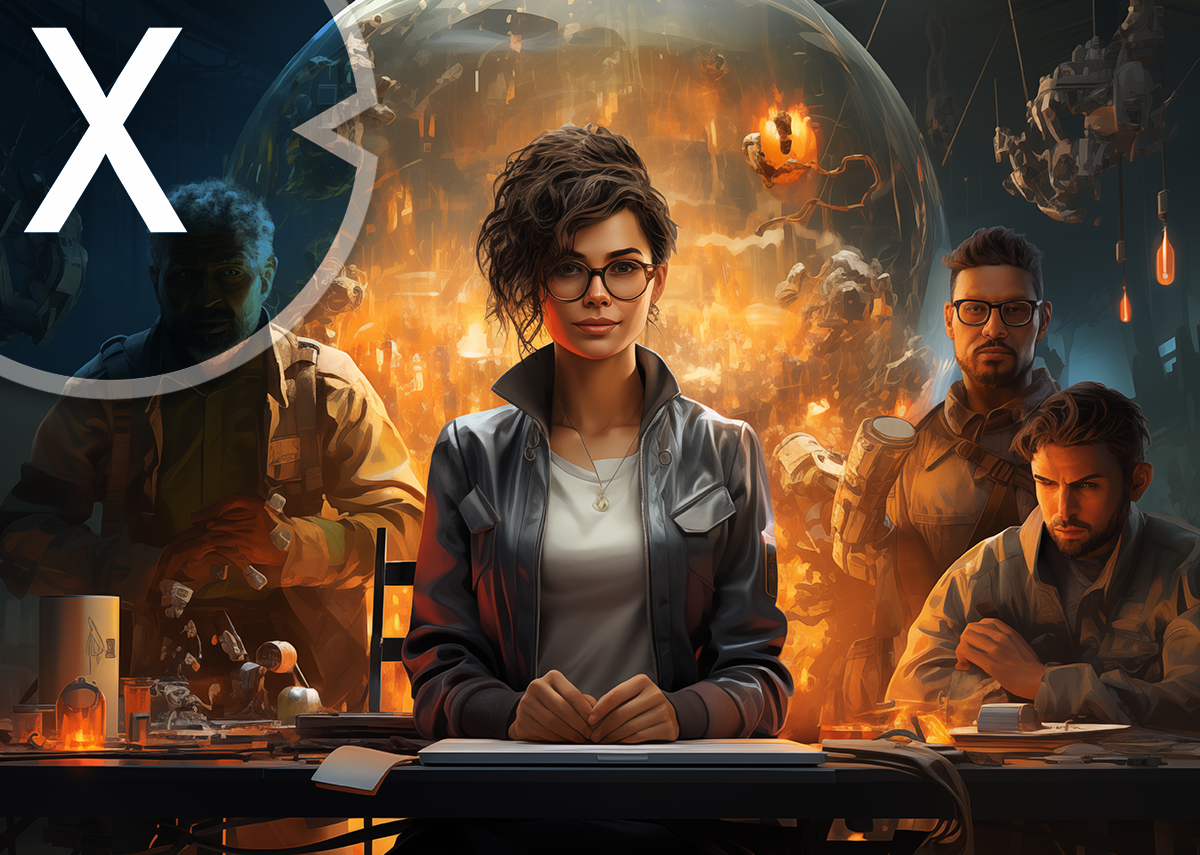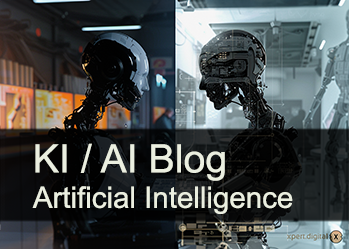The end of AI faces? Is Google solving the biggest problem in image generation with Gemini 2.5?
Xpert pre-release
Language selection 📢
Published on: October 4, 2025 / Updated on: October 4, 2025 – Author: Konrad Wolfenstein

The end of AI faces? Is Google solving the biggest problem in image generation with Gemini 2.5? – Creative image: Xpert.Digital
Google Gemini 2.5 Flash Image (Nano Banana) – Faster, cheaper, better: Google wants to conquer the AI image market
The attack on Midjourney, DALL-E and even Photoshop: Why Google's new image AI could change everything
Codenamed "Nano Banana," a mysterious AI model caused a sensation in anonymous tests, outperforming the competition before Google revealed the secret: Behind it lies Gemini 2.5 Flash Image, the latest generation of AI image processing and a direct attack on established giants such as Midjourney and DALL-E 3. The model not only relies on a playful name that has now achieved cult status, but also convinces with hard facts: an impressive generation speed of around three seconds, significantly lower costs than the competition, and a groundbreaking ability for character consistency that solves one of the biggest problems of previous image AIs.
However, its true strength lies in its intuitive usability. Instead of using complex tools, users can edit images simply by typing – from blurring the background to changing a person's pose, all controlled by the semantic understanding of the multimodal Gemini AI. With this, Google not only democratizes professional image editing but also offers developers and creatives an extremely powerful tool that can be integrated into their own applications with just a few lines of code. This article comprehensively explores what Gemini 2.5 Flash Image is all about, its technical specifications, and how it could fundamentally change the landscape of AI image generation.
Suitable for:
What is Google Gemini 2.5 Flash Image and why is it called “Nano Banana”?
Google Gemini 2.5 Flash Image, known internally as "Nano Banana," is Google's newest and most advanced image generation and editing model. The codename "Nano Banana" originated during the development phase and was initially used in anonymous tests in LMArena's Image Edit Arena, where the model attracted attention for its exceptional performance before its true identity was revealed.
The model was officially introduced by Google at the end of August 2025 as part of the Gemini 2.5 Flash family. The playful name "Nano Banana" has since become a trademark, used by both developers and the community. Even high-ranking executives like Nvidia CEO Jensen Huang commented positively on the "Nano Banana" phenomenon, prompting Google CEO Sundar Pichai to respond: "Mine Too."
What technical specifications and features does the model offer?
Gemini 2.5 Flash Image is based on Google's proprietary TPU v5 infrastructure and uses 32,768 input and 32,768 output tokens. The average generation latency is an impressive 3.2 seconds for standard 1024×1024 images, while batch processing reduces the time per image to 2.1 seconds for more than 10 simultaneous generations.
The model supports up to 10 concurrent requests per API key, with Enterprise accounts able to obtain higher limits through quota adjustment requests. The rate limit is 1,000 requests per minute for Standard accounts and can be scaled to 10,000 requests per minute for Enterprise implementations.
A unique feature is the support of ten different aspect ratios. These include landscape formats such as 21:9, 16:9, 4:3, and 3:2; the square format 1:1; portrait formats such as 9:16, 3:4, and 2:3; and flexible formats such as 5:4 and 4:5. This diversity allows developers to create content for a wide range of applications, from cinematic formats to social media posts.
How does image editing via text input work?
The strength of Gemini 2.5 Flash Image lies in its ability to understand and implement complex image processing using natural language. The model leverages the world knowledge of Google's multimodal Gemini AI to semantically understand prompts and generate realistic implementations.
Users can specifically modify specific image elements without requiring complex masks or technical knowledge. Examples of possible edits include blurring the background, removing objects, changing colors, or adjusting details such as a person's pose. These semantically controlled interventions enable significantly more intuitive and flexible editing than conventional UI-based tools.
The model can also edit images step by step without obscuring the central subject. This multi-turn editing feature means users can upload an image, make initial edits, and then make further changes to the updated image, with the AI taking into account the context of previous commands.
What makes character consistency so special?
One of the most outstanding features of Gemini 2.5 Flash Image is its ability to provide consistent character representation across multiple images. The model can realistically represent a person or any object specified by a photo in other scenes defined by a prompt, even together with other people or objects.
Character consistency works by analyzing and extracting key identity markers from reference images. These include facial structure and bone points, unique markings such as scars or birthmarks, color palettes for eye, hair, and skin color, as well as stylistic elements and typical outfit choices.
When new variations are generated, the system preserves these core identity markers while adapting the rendering rules to the desired style, whether realistic, cartoonish, or anime-inspired. The result is consistent character AI that remains recognizable across different artistic treatments.
Developers report a 40-60% improvement in inconsistency problems compared to other models. This makes the model particularly valuable for applications such as comic creation, animation, game development, and serialized storytelling.
How can developers integrate the model into their applications?
Gemini 2.5 Flash Image is accessible through multiple channels. Developers can leverage the model for enterprise applications through the Gemini API, Google AI Studio, and Vertex AI. Integration is remarkably simple—developers can implement full image generation capabilities with fewer than 20 lines of code, significantly reducing development time for AI-powered applications.
Google AI Studio offers an enhanced "Build Mode" that allows developers to create working prototypes from simple text inputs. These can be run directly in Google AI Studio or exported as code. Build Mode was recently updated with GitHub integration, support for Angular alongside React, and an expanded template library.
For enterprises, Vertex AI is available as an enterprise platform, offering a 99.2% uptime guarantee and seamlessly integrating with existing Google Cloud infrastructures. The model supports OAuth 2.0 authentication with scope-specific permissions for image generation endpoints.
A notable partnership is with OpenRouter.ai, which offers the first image model on its platform and makes it available to 3+ million developers worldwide. This significantly expands the reach and offers alternative integration options for developers.
What are the costs of using it?
Gemini 2.5 Flash Image's pricing is competitive and transparent. The model costs $0.039 per generated image, which equates to $30 for one million output tokens. Each generated image typically consumes 1,290 tokens.
Compared to the competition, this offers significant cost savings: DALL-E 3 costs $0.040 per image (2.5% more expensive), and Midjourney costs $0.280 per image (86% more expensive than Gemini). These price advantages make the model particularly attractive for high-volume applications.
Google offers generous free tiers for development and testing: The free tier includes 500 daily requests, 250,000 tokens per minute, and full access via Google AI Studio with no geographical restrictions. Enterprise customers benefit from volume discounts starting at 100,000 monthly generations and can receive committed-use discounts of up to 35% for annual contracts over $50,000.
A particularly attractive offer is the batch mode, which offers a 50% discount on standard pricing. This is suitable for non-real-time use cases such as content preprocessing, dataset generation, and scheduled social media posts, with results available within 24 hours.
What practical application examples are there?
Google has developed several sample applications that demonstrate the model's versatility. Bananimate is a GIF animator that uses the "Nano Banana" mascot and allows users to create animated GIFs from images and prompts. Enhance is a creative zoom tool with a hidden Easter egg that functions as an infinite zoom creative upscaler for photos. Fit Check is a virtual fitting room that enables outfit previews using AI.
Companies are already successfully using the model. Cartwheel combines Gemini 2.5 Flash Image with its 3D posing tool, allowing users to render characters from any angle. Co-founder Andrew Carr reports that other models struggle with either perspective or context, but Gemini 2.5 Flash Image handles both simultaneously.
Volley, an AI studio, uses the model in its game "Wit's End" to generate portraits, scene transitions, and image editing on demand. CTO James Wilsterman reports latency times of under ten seconds, allowing players to control everything in real time via voice or chat.
Other applications include product photography, fashion photography, social media content, virtual clothing fitting, interior design visualization, and the creation of consistent AI influencers. The model is particularly suitable for projects that require consistent character designs and flexible image processing.
A new dimension of digital transformation with 'Managed AI' (Artificial Intelligence) - Platform & B2B Solution | Xpert Consulting

A new dimension of digital transformation with 'Managed AI' (Artificial Intelligence) – Platform & B2B Solution | Xpert Consulting - Image: Xpert.Digital
Here you will learn how your company can implement customized AI solutions quickly, securely, and without high entry barriers.
A Managed AI Platform is your all-round, worry-free package for artificial intelligence. Instead of dealing with complex technology, expensive infrastructure, and lengthy development processes, you receive a turnkey solution tailored to your needs from a specialized partner – often within a few days.
The key benefits at a glance:
⚡ Fast implementation: From idea to operational application in days, not months. We deliver practical solutions that create immediate value.
🔒 Maximum data security: Your sensitive data remains with you. We guarantee secure and compliant processing without sharing data with third parties.
💸 No financial risk: You only pay for results. High upfront investments in hardware, software, or personnel are completely eliminated.
🎯 Focus on your core business: Concentrate on what you do best. We handle the entire technical implementation, operation, and maintenance of your AI solution.
📈 Future-proof & Scalable: Your AI grows with you. We ensure ongoing optimization and scalability, and flexibly adapt the models to new requirements.
More about it here:
Free today, expensive tomorrow? Strategic risks and opportunities with Gemini 2.5
What are the technical limitations and challenges?
Despite its impressive capabilities, Gemini 2.5 Flash Image has certain limitations. The model has a knowledge base valid until June 2025 and is available in limited regions. Currently, it is primarily designed for web apps; native mobile or desktop apps are not yet supported.
A known problem occurs with multiple rounds of editing: After multi-turn editing, image quality can degrade, and faces may appear slightly distorted. This is especially relevant for applications that require multiple consecutive edits.
Its dependence on the Google ecosystem could be problematic for some developers, and backend integration options are still evolving. As a newer tool, it has a smaller community compared to established platforms like Midjourney or DALL-E.
Strategic risks exist in the current free availability, as Google could potentially introduce premium tiers, usage restrictions, or price increases in the future. Developers are therefore advised not to put all resources on a single platform and to regularly export and back up projects.
Suitable for:
- Google Glitches | The Glossy World of Google AI Image Generation (Gemini Imagen with Nano Banana) – Great on the Outside, Bad on the Inside
How does the model differ from the competition?
Gemini 2.5 Flash Image stands out from the competition with several unique features. Character consistency is significantly better than other models—users report that it "completely destroys Flux context" in preserving facial features and seamlessly integrating edits with backgrounds.
Speed is another key advantage: While Midjourney takes 30-60 seconds to generate, Nano Banana delivers results in 3-5 seconds. DALL-E 3 takes 6-8 seconds, but is still slower than Google's solution.
The multi-image fusion capabilities are particularly advanced. The model can understand and merge multiple input images, place objects in scenes, redesign spaces with color schemes or textures, and blend images with a single prompt. This functionality goes beyond what most competing models offer.
Another important difference is the integration of Gemini's world knowledge. While most image generation models excel at creating aesthetic images but lack a deep, semantic understanding of the real world, Gemini 2.5 Flash Image benefits from Gemini's extensive world knowledge, enabling new use cases.
What security features and watermarks are used?
Google has integrated security and traceability into Gemini 2.5 Flash Image as central aspects. All images created or edited with the model contain an invisible SynthID watermark, which serves to secure image distribution and authentication.
The SynthID system makes it possible to identify AI-generated content even after various processing steps. This is especially important at a time when distinguishing between real and AI-generated content is becoming increasingly difficult.
When used via Google Gemini, all generated images are automatically watermarked. Users who require watermark-free images must resort to paid API access or third-party platforms such as OpenRouter.ai.
Google has also implemented responsible AI use guidelines that restrict certain types of content. The model is trained to identify problematic content and refuse to generate it.
How is it integrated into existing development workflows?
Integrating Gemini 2.5 Flash Image into existing development workflows is possible through several approaches. Google AI Studio offers a streamlined no-code development flow that uses generative AI to develop, test, iterate, and release complete, agentic web apps.
Developers can describe their app idea using natural language and automatically receive an app blueprint with a suggested name, required features, and style guidelines. Build Mode can transform simple prompts into working prototypes that can run directly in AI Studio or be exported as code.
The new GitHub integration is especially valuable for professional development workflows. Developers can synchronize projects directly with GitHub repositories, including options for public or private repos. The AI even generates intelligent commit messages that describe exactly what has changed in the code.
For enterprise applications, Vertex AI offers full CI/CD pipeline integration and one-click deployment on platforms like Vercel, enabling a complete development workflow from idea to production.
What future developments can be expected?
Google is continuously working on further developing Gemini 2.5 Flash Image. The model is currently in preview and will be fully stable in the coming weeks. The roadmap points to further improvements in image quality, additional aspect ratios, and expanded editing features.
Integration with other Google services is expected to expand. Firebase Studio is already expanding its prototyping capabilities, and further integrations with Google Cloud services are planned. The Build Mode in Google AI Studio is continuously receiving updates, with more improvements planned.
Community reactions and developer feedback actively inform product development. Google collects extensive feedback across its various platforms and template apps to prioritize future improvements.
In the long term, the model could gain support for native mobile and desktop apps, as well as expanded video and animation capabilities. The successful partnership with OpenRouter.ai suggests that Google is ready to expand the ecosystem and enable more third-party integrations.
How does Gemini 2.5 Flash Image impact the AI image generation landscape?
Gemini 2.5 Flash Image is already having a significant impact on the AI image generation industry. The model quickly climbed to the top of the AI image editor and generator rankings on the benchmark site lmarena.ai, even before its true identity was revealed.
The launch has intensified competition and put pressure on other vendors to rethink their pricing and features. At $0.039 per image, Google significantly undercuts both OpenAI and Midjourney, setting a new standard for the industry.
The model's high speed and quality are changing user expectations. Social media trends like the "Nano Banana" trend on TikTok demonstrate how quickly AI-generated content can become mainstream. Reports indicate that over 200 million images have already been created or modified using the tool.
For the creative industry, this means a further democratization of professional image editing. Tools that previously required specialized software and expertise will become accessible through natural language commands. This could fundamentally change traditional image editing workflows.
The integration of AI world knowledge into image generation sets new standards for semantic understanding in visual AI systems. This could encourage other vendors to pursue similar approaches and combine their models with more comprehensive knowledge databases.
Has the problem with the AI faces been solved in Nano Banana?
Anyone who works with AI image generators knows the problem all too well: distorted, inconsistent faces that change from frame to frame, rendering characters unrecognizable. With Gemini 2.5 Flash Image, aka "Nano Banana," Google now appears to have largely solved this persistent problem, delivering one of the best solutions for character consistency on the market to date.
The secret lies in the model's ability to understand a person not just superficially, but structurally. Instead of guessing with each new generation, the AI analyzes crucial identity markers from a reference image. These include basic facial structure, bone points, unique features such as scars or birthmarks, and the color palettes of eyes, hair, and skin. These core characteristics are preserved even when the character is rendered in entirely new scenes, poses, or artistic styles. Developers report an impressive 40-60% reduction in inconsistency issues compared to other models.
However, the solution isn't entirely perfect and has one important limitation: multiple, consecutive edits of the same image (so-called "multi-turn editing") can cause quality to suffer. Nevertheless, after multiple editing steps, image quality degrades, and faces may appear "slightly distorted."
In plain language, this means: For creating a consistent character across different scenes—ideal for comics, storyboards, or virtual influencers—Nano Banana is a huge breakthrough. The problem of "AI grimaces" is largely solved here. However, anyone planning to repeatedly change a single image in many small steps should expect a potential loss of quality.
Your AI transformation, AI integration and AI platform industry expert
☑️ Our business language is English or German
☑️ NEW: Correspondence in your national language!
I would be happy to serve you and my team as a personal advisor.
You can contact me by filling out the contact form or simply call me on +49 89 89 674 804 (Munich) . My email address is: wolfenstein ∂ xpert.digital
I'm looking forward to our joint project.
☑️ SME support in strategy, consulting, planning and implementation
☑️ Creation or realignment of the AI strategy
☑️ Pioneer Business Development
🎯🎯🎯 Benefit from Xpert.Digital's extensive, fivefold expertise in a comprehensive service package | R&D, XR, PR & SEM

AI & XR 3D Rendering Machine: Fivefold expertise from Xpert.Digital in a comprehensive service package, R&D XR, PR & SEM - Image: Xpert.Digital
Xpert.Digital has in-depth knowledge of various industries. This allows us to develop tailor-made strategies that are tailored precisely to the requirements and challenges of your specific market segment. By continually analyzing market trends and following industry developments, we can act with foresight and offer innovative solutions. Through the combination of experience and knowledge, we generate added value and give our customers a decisive competitive advantage.
More about it here:






















